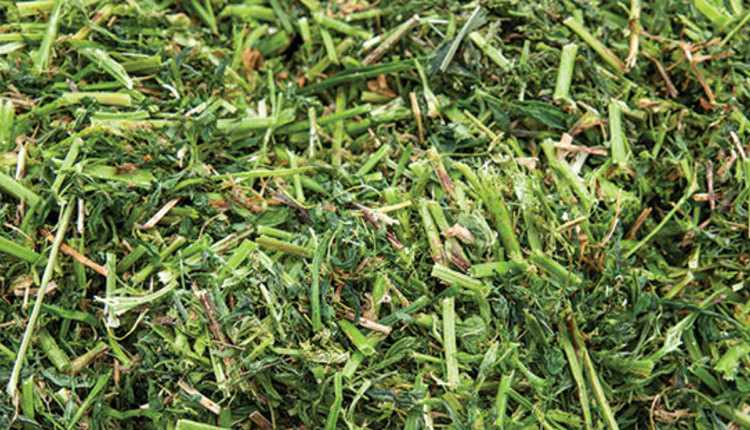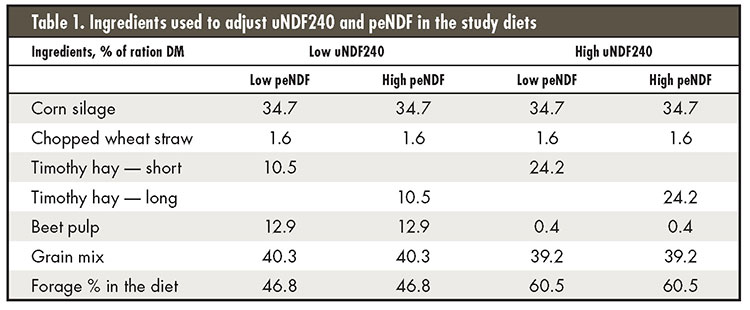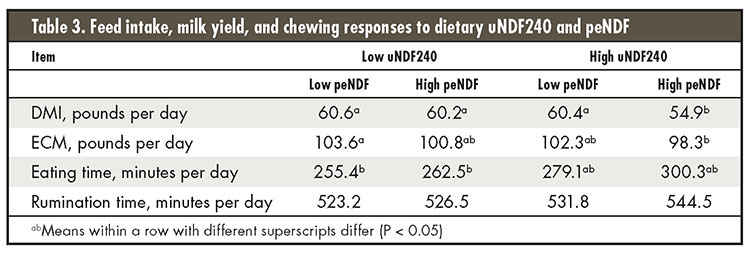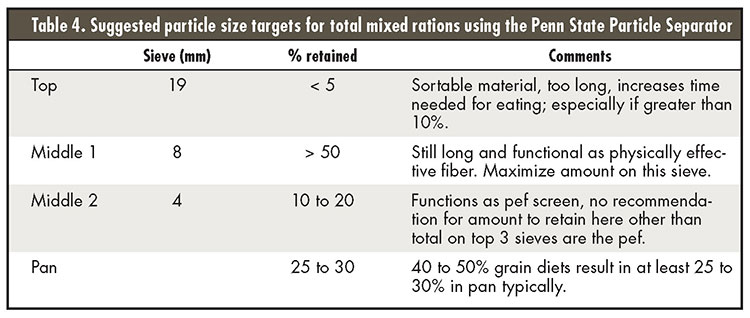Rethinking forage particle size |
| By Rick Grant |
|
|
The author is the president of the William H. Miner Agricultural Research Institute in Chazy, N.Y. How forage particle size and NDF digestibility interact to affect dry matter intake (DMI) and milk yield is a hot topic among dairy nutritionists. Physically effective neutral detergent fiber (peNDF) describes the particle size of the forage and is usually measured on-farm using the 4-millimeter (mm) screen of the Penn State Particle Separator. Undigested NDF tells us quite a bit about the indigestible and potentially digestible NDF in a forage and is commonly measured as the undigested NDF following 240 hours of in vitro fermentation (uNDF240). These two fiber measures allow us to do a much better job of predicting the cow’s response to forage-NDF. At Miner Institute, our recent forage research has focused on several practical feeding questions relating to forage particle size and fiber indigestibility:
With the new approaches to measuring NDF digestibility (for example, uNDF240, fast-digesting NDF, and slow-digesting NDF), some nutritionists have even questioned whether particle size is actually that important to measure and monitor. Our work indicates that particle size, measured as peNDF, is important — but likely not for the reasons we have always focused on such as rumination. Actually, forage particle size seems to influence eating time more than ruminating time in our common corn silage-based diets, which has important consequences for the cow’s time budget and feedbunk management. Particle size matters To begin understanding how particle size and NDF indigestibility affect DMI and milk production, we conducted a study designed to evaluate a lower (8.9 percent of ration DM) and higher (11.5 percent of ration DM) dietary uNDF240 with either high or low peNDF. Table 1 provides the ingredient makeup of the diets we fed in the study.  All four contained the same amount of corn silage and chopped wheat straw, and then particle size and uNDF240 content were adjusted using timothy hay at two chop lengths and some pelleted beet pulp to further reduce uNDF240. A Haybuster, with its hammer mill chopping action, created the two particle sizes of the forage. The low uNDF240 diets contained about 47 percent forage and the high uNDF240 diets contained about 60 percent forage on a dry basis.  Table 2 shows the four diets and their uNDF240 and peNDF content. These range in fiber uNDF240, and peNDF of these four diets reflect the corn silage-based diets that we would often see in the Upper Midwest and northeastern U.S. We also calculated a new fiber value — “physically effective uNDF240, peuNDF240,” which is obtained simply by multiplying the uNDF240 value of the diet by the physical effectiveness factor (pef). The pef is the fraction of a forage or feed that is retained on the 4-mm sieve and greater when using the Penn State Particle Separator on as-fed samples (or the 1.18-mm screen if dry sieving in a lab). Note that the low uNDF240, high peNDF diet and the high uNDF240, low peNDF diets, although differing in uNDF240 and peNDF, contain the same peuNDF240 value. Considering the effects of particle size and uNDF240 together (as with peuNDF240) provides us with one number that helps to explain cow productive responses as shown in Table 3.  The diets that contained the extremes in either uNDF240 or peNDF (low uNDF240 and peNDF versus high uNDF240 and peNDF) consistently and predictably differed in DMI, energy-corrected milk, and chewing behavior. The two intermediate diets that contained either low uNDF240 and high peNDF or high uNDF240 and low peNDF yielded similar DMI and energy-corrected milk. Importantly, cows had similar energy-corrected milk production regardless of whether the diet was higher in uNDF240 but chopped more finely or lower in uNDF but with a coarser particle size. This is useful information to have in the field as we formulate diets with a range of forage quality. These results indicate that if forage NDF indigestibility gets a little too high, we can at least partially compensate by moving to a smaller theoretical length of cut (TLC) or chopping dry forages more finely. Long will prolong Cows on the low uNDF240, low peNDF treatment spent about 45 minutes less each day at the bunk eating — while eating over 5 pounds per day more of the diet! The difference in eating time was explained by the time it takes the cow to chew and reduce the dietary particle size when she eats it. Cows fed these types of silage-based diets tend to chew the diet to a relatively uniform particle size before swallowing. So, rumination time will be essentially unaffected. This is a major point: Very long particles in the ration will just prolong eating time, without providing the cow any greater rumination stimulation. Excessive time spent at the bunk chewing feed in order to swallow it needs to be avoided because cows in freestall housing should not spend more than five hours per day eating in order to have natural feeding behavior.  Based on this work and other published studies, we have developed guidelines for the Penn State Particle Separator that should result in total mixed ration (TMR) particle distributions that optimize time spent eating at the feedbunk and ruminating (Table 4). And, although still a work in progress, Table 5 suggests silage TLC and particle distributions for individual forages in order to achieve desirable TMR particle size distributions. These numbers come from our experience here at Miner Institute and feedback from field nutritionists across the U.S.  Final perspectives Physically effective uNDF240 (pef times uNDF240) seems to be a useful concept when formulating corn silage- and haycrop silage-based diets. It combines a common measure of particle size (pef from the Penn State Particle Separator or dry sieving in the lab) with uNDF240. Cows responded the same whether the diet had lower uNDF240 chopped more coarsely or higher uNDF240 chopped more finely. We also need to remember that adequate peNDF is important for low uNDF240 diets. If future research confirms this response across a wider range of forage types, then when forage fiber digestibility is lower than desired, a finer forage chop length should enhance feed intake and energy-corrected production. This article appeared in the November 2019 issue of Hay & Forage Grower on page 30. Not a subscriber? Click to get the print magazine. |
